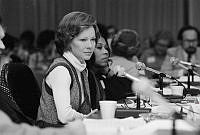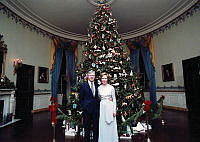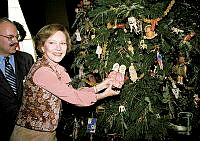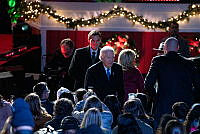Eleanor Roosevelt's "My Day": Causes
Copyright © White House Historical Association. All rights reserved under international copyright conventions. No part of this article may be reproduced or utilized in any form or by any means, electronic or mechanical, including photocopying, recording, or by any information storage and retrieval system, without permission in writing from the publisher. Requests for reprint permissions should be addressed to books@whha.org
Eleanor Roosevelt (ER) considered herself a resident of Washington, D.C. and took an active part in the city's life during the Franklin D. Roosevelt administration. Her activism stemmed from her conviction that the nation's capital belonged "to every citizen of the United States" and should be a place where "people . . . [who] have an interest in certain social questions . . ." could "find the pattern here . . . they wish to develop at home." Unfortunately, many of Washington's social programs in the 1930's and 1940's lacked funds because the U.S. Congress, which governed the District, did not "show the interest . . . needed to run a community." ER believed that first-hand knowledge and citizen action could change this situation. "We must know about these conditions if we are to remedy them," she wrote in "My Day." "Therefore I have decided to see with my own eyes just what they are . . ."
Her first public act as first lady was to tour the city's alley slums with one of Washington's leading civic activists, Charlotte Everett Hopkins. Appalled at the squalor she found (uncollected garbage, limited sanitation, rats as big as cats), ER took action. As honorary chairman of the Washington Committee on Housing, she helped develop and secure passage of legislation that led to the creation of the Alley Dwelling Authority in 1934. That group was charged with the demolition of the alley slums and the construction of new housing. Almost ten years later in the midst of World War II, ER told readers of her column that "considerable constructive work has been done to eliminate bad places and to increase decent housing but it has never gone fast enough. . . ."
ER also took an active role in the federal government's construction of planned communities for people of modest means. She reviewed the plans for Greenbelt, Maryland, the first of three suburban "greenbelt" communities, (named for the swath of agricultural land that surrounded them) located "just across the District line in Maryland" and visited several times. In 1937 when critics complained about its cost, she defended the community arguing that "it is possible that some people do not believe that the government has a duty to point the way for better housing for low income groups, but if anybody believes that an effort should be made . . . I think they could hardly object to what has been done in Greenbelt."

Eleanor Roosevelt and Marian Anderson in Japan in 1953.
Franklin D. Roosevelt Presidential Library and Museum/NARAShe also supported local public-private housing partnerships as a way to solve housing shortages, build community and provide employment during the Depression. After her 1937 visit to Buckingham Village, a housing development built with federal funds and private money in Arlington, Virginia, she praised it as "well-planned . . . and easy . . . to live in." However, she wondered if residents "could not combine and find a trained person to supervise" their children on the project's playground to keep their offspring safe and employ "one more person."
With the advent of World War II, District housing conditions became more urgent as thousands of military and non-military personnel converged on Washington. ER took particular interest in the development of civilian housing for female government workers, many of whom lived far from family and friends. In 1943, for example, she made two visits to Arlington Farms, a government-funded defense housing project consisting of dormitories, shops, a cafeteria and a recreation building in suburban Virginia. ER also visited the construction site of a similar project for African American women war workers which she noted would be built "exactly the same as . . . Arlington" with the same materials and facilities.
ER's work with housing dovetailed with her fight against racial prejudice and discrimination. In the 1930's and 1940's, Washington remained a segregated city, and little support existed either in Congress or the community to change the status quo. ER, who considered racial prejudice undemocratic and immoral, devised a two-pronged strategy to attack segregation in the District. First, she publicly supported African American organizations and institutions. For example, she became the first white D.C. resident to join the local chapters of the NAACP and the National Urban League. She raised money for Howard University and lobbied Congress for increased appropriations for Freedman's Hospital. She also visited other District facilities that served African Americans and publicized the often sub-optimal conditions she found there. ER endorsed local African American efforts to end segregation as well. When Howard University students picketed lunch stands that denied them service, she praised their courage and sent them money so they could continue their public education programs. After local groups picketed Washington's Keith Theatre to protest its segregated seating policy, ER wrote about her reluctance to cross the picket line to attend a charity performance of the film, Abe Lincoln in Illinois. Although the sponsoring organization "had a right to sell its tickets to whomever it wished," ER said "there was [a] . . . question here of unjust discrimination. . . . This occurrence in the nation's capital was . . . a symbol of the fact that Lincoln's plea for equality of citizenship and for freedom, has never been quite accepted in our nation."
Her most famous effort to encourage racial tolerance in the District occurred in 1939 when she resigned from the Daughters of the American Revolution (DAR) after the group refused to allow contralto Marian Anderson to use their Washington, D.C. auditorium. ER's February 27 column explaining her decision and her subsequent support for Anderson's concert transformed a local act into a national disgrace.
ER's desire to see with her own eyes encompassed the arts. She had a vision for what the arts could mean in a democracy, and she worked to implement it. For example, she supported efforts to create the Public Works Arts Project (PWAP) and later lobbied FDR to create Federal Project Number 1 (a group of arts programs that included the Federal Theater Project, the Federal Writers' Project, the Federal Music Project and the Federal Art Project). She then used her My Day column to publicize the work of these projects especially those based in Washington, D.C. For example, she reported on her visits to the Treasury Department to see the art commissioned for federal buildings and wrote about how "thrilling" it was "that the government for the first time . . . is actually giving consideration to things which will make living richer for all of us." She watched artist George Biddle paint a mural on the walls of the newly-built Justice Department building and highlighted the work of Native American artists at work on the new Department of the Interior building. She also opened two exhibits of New Deal art work, a 1934 national exhibition of PWAP artists' work at the Corcoran Gallery and a 1935 show of work artists had done at Civilian Conservation Corps camps called "Life in the CCC" at the National Museum.
ER's work for the arts as well as her efforts to improve housing conditions and end racial discrimination in the District stemmed from her conviction that "every citizen" should take "an interest in making the Capital of the United States a model from every point of view." She never stopped trying to make the nation's capital a place where visitors from every state and nation could see what "government at its best could do. . . ." Her willingness to engage with the District and devise solutions to meet real needs improved residents' lives, helped alleviate racial discrimination, and made government-supported art programs an important part of the city's cultural landscape.





































